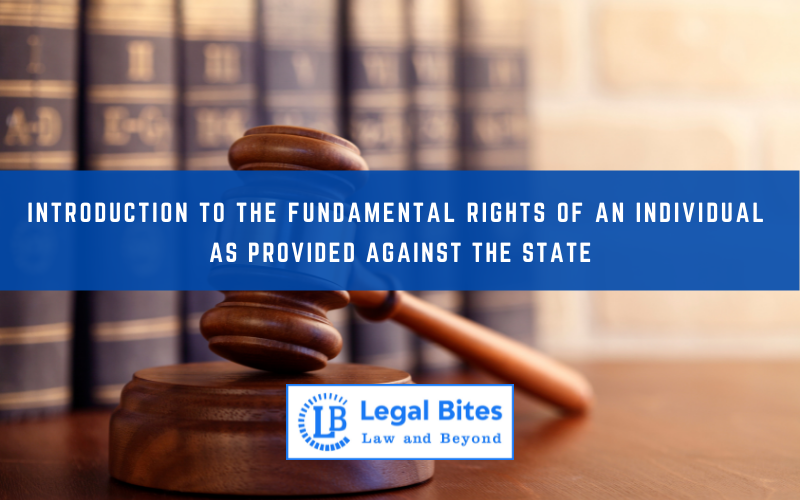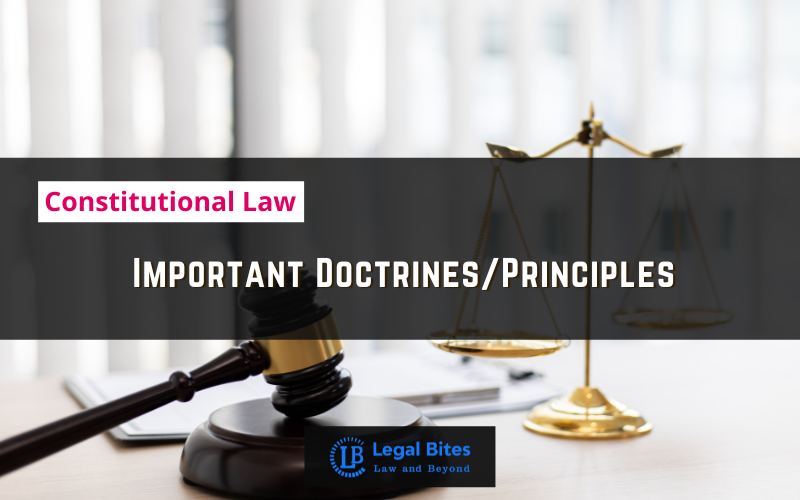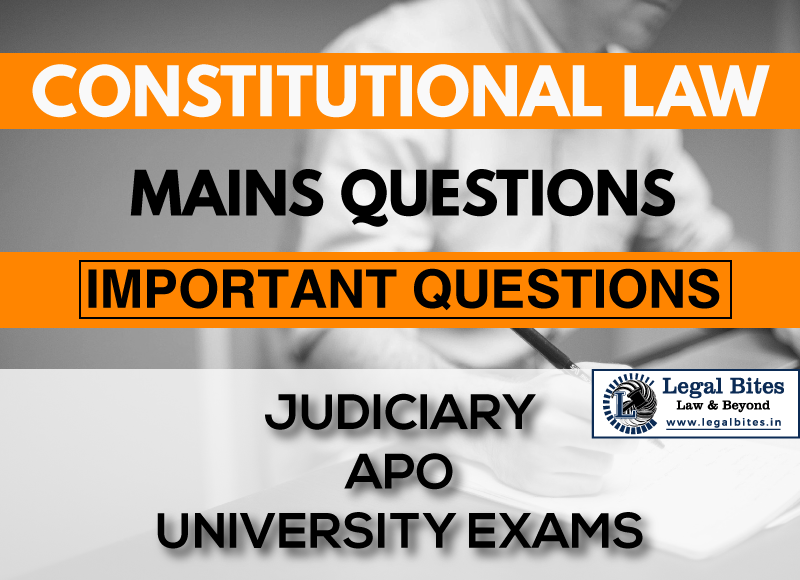Introduction to the Fundamental Rights of an Individual: As provided against the State
Part III of the Constitution contains a long list of fundamental rights. This Chapter of the Constitution of India has very well been described as the Magna Carta of India.[1] The inclusion of a Chapter of Fundamental Rights in the Constitution of India is in accordance with the trend of modern democratic thought, the idea being to preserve… Read More »
;
Part III of the Constitution contains a long list of fundamental rights. This Chapter of the Constitution of India has very well been described as the Magna Carta of India.[1] The inclusion of a Chapter of Fundamental Rights in the Constitution of India is in accordance with the trend of modern democratic thought, the idea being to preserve that which is an indispensable condition of a free society. Introduction to the Fundamental Rights of an Individual The aim of having a declaration...
Part III of the Constitution contains a long list of fundamental rights. This Chapter of the Constitution of India has very well been described as the Magna Carta of India.[1] The inclusion of a Chapter of Fundamental Rights in the Constitution of India is in accordance with the trend of modern democratic thought, the idea being to preserve that which is an indispensable condition of a free society.
Introduction to the Fundamental Rights of an Individual
The aim of having a declaration of fundamental rights is that certain elementary rights, such as right to life, liberty, freedom of speech, freedom of faith and so on, should be regarded as inviolable under all the conditions and that the shifting majority in Legislature of the Country should not have a free hand in the Barnet.[2]
“Fundamental rights are the rights having a noble pedigree. They are the natural rights which are in the nature of external conditions necessary for the greatest possible unfolding of the capacities of a human being. These secured and guaranteed conditions are called fundamental rights. It is generally agreed that these natural rights are inherent in man and cannot be taken away by the State.”[3]
These fundamental rights substantially cover all the traditional civil and political rights enumerated in the Universal Declaration of Human Rights. Dr. Ambedkar described them as “the most criticized part” of the Constitution.
Fundamental rights were deemed to be essential to protect the rights and liberties of the people against the encroachment of the power delegated by them to their government. They are the limitations upon all the powers of the Government, legislative as well as executive.
In Maneka Gandhi Case[4], Bhagwati, J., observed: “These Fundamental rights represent the basic values cherished by the people of this country since the Vedic times and they are calculated to protect the dignity of the individual and create conditions in which every human being can develop his personality to the fullest extent. They weave a ‘pattern of guarantee’ on the basic structure of the human rights, and impose negative obligations on the State not to encroach on the individual liberty in its various dimensions.”
The object behind the inclusion of them in the Constitution is to establish ‘a government of law and not of man’. The object is to establish rule of law. The object is not merely to provide security and equality of citizenship of the people living in this land and thereby helping the process of nation-building, but also and not less important to provide certain standards of conduct, citizenship, justice and fair play.[5]
In M. Nagraj v. Union of India,[6] the Supreme Court spoke about the importance of the fundamental rights- the fundamental rights are not the gifts from the State to citizens. Part III does not confer fundamental rights but confirm their existence and give them protection. Individuals possess basic human rights independently of any constitution by reason of the basic fact that they are a human race. These rights are important as they possess intrinsic values. Its purpose is to withdraw certain subjects from the area of political controversy to place them beyond the reach of majorities and officials and to establish them as legal principles to be applied by the Courts.
New Judicial Trends in Interpreting Provisions of Part III
- Widest Interpretation of provisions of Part III- in Maneka Gandhi Case[7], the Supreme Court has held that the provisions of Part III should be given widest possible interpretation. Delivering the judgement, Bhagwati, J., said, “The correct way of interpreting the provisions of Part III is that attempt of the court should be to expand the reach and ambit of the fundamental rights rather than to attenuate their meaning and content”.
In Gopalan’s case[8], the Court had taken the view that each Article dealt with separate rights and there was no relation with each other. In other words, they were mutually exclusive. This view has been held to be wrong in Maneka Gandhi’s case[9] where the Court has taken the view that they are mutually exclusive but form a single scheme in the Constitution that is they are all parts of an integrated scheme in the Constitution.
The validity of a law infringing fundamental rights can be judged not only with reference to a particular Article under which such a law is enacted but also with reference to other articles. In Gopalan’s case[10] it was held that the validity of a deprivation law enacted under Article 21 could not be tested under Article 19. This view has now been overruled in Maneka Gandhi’s case[11] and it has been held that a law depriving a person of his personal liberty under Article 21 must also satisfy the test of ‘reasonableness’ under Articles 14 and 19 of the Constitution.
- Natural Justice and due Process – in Maneka Gandhi’s case[12] the Supreme Court has held that the ‘procedure’ depriving a person of his ‘life or personal liberty must be just, fair and reasonable’. It must satisfy the requirement of natural justice which is an essential component of fair procedure under Article 21. “Natural justice is a distillate of due process” observed Krishna Iyer, J., the concept of natural justice and due process which were rejected in Gopalan’s case forming part of our Constitutional scheme guaranteeing fundamental rights.
- Prisoners’ rights and Prison Reforms- the Supreme Court has considerably widened the scope of Article 21 and has held that its protection will be available for safeguarding the fundamental rights of the prisoners and for effecting prison reforms. Convicts are also human beings and until they are hanged they are entitled to live in jail as human beings and not slaves. Inhuman and barbarous treatment with Solitary confinement, hand-cuffing, harsh labour, degrading jobs and punishments in jail without judicial approval violate the mandate of Article 21 of the Constitution. Speedy trial and legal aid to the poor prisoners are constitutional rights available to them and does not depend upon the mercy of the state.
- Expanding the role of writ of Habeas Corpus- the dynamic role of judicial remedies after the Sunil Batra’s case[13] imparts to the writ of habeas corpus with a versatile vitality and operational utility as a bastion of liberty even within the jails. Wherever the right of prisoner either under the Constitution or under other law are violated the writ power of the Court can and should run to rescue. The habeas corpus writ can be issued not only for releasing of a person from illegal detention but also for directing the jail authorities to provide necessary amenities to the prisoners and to protect them from inhuman and barbarous treatment. In ABSK Sangh (Rly.) v. Union of India[14], it has been held that even an unregistered association can maintain a petition for relief under Article 32 of the Constitution if there is a common grievance. Thus, Article 32 is not confined to protecting only an individual’s fundamental rights but is capable of doing justice wherever it is found and the society has an interest in it. “Access to justice through ‘class actions’, ‘public interest litigation’ and ‘representative proceedings’ is the modern jurisprudence”, declared Krishna Iyer, J., in the historic judgement of Judges Transfer case[15].
- Human Rights Jurisprudence- the Supreme Court has now moved to more of Human rights, particularly for protecting from inhuman and barbarous treatment. Krishna Iyer, J., in Sunil Batra’s case[16] has said “today, human rights jurisprudence in India has Constitutional Status.”
In 1979, India became the party to ICCPR. Article 10 of the ICCPR provides that “all persons deprived of their liberty shall be treated with humility and with respect for the inherent dignity of the human persons. Article 5 of the U.N. Declaration of Human Rights, 1948 says, “No one shall be subject to the torture or to cruel, inhuman or degrading treatment or punishment”.
In Prem Shankar v. Delhi Administration[17], Krishna Iyer, J., said that in interpreting the Constitutional and statutory provisions the Court must not forget the core principle found in Article 5 of UDHR, 1948. Homage to human rights which calls for prisons, prison staff and prisoners reform, his Lordship Declared.
Suspension of Fundamental Rights
Fundamental rights are the natural rights of individuals but to avoid its misuse it has been imposed with certain restrictions. Fundamental rights are not absolute rights, the Constitution provides for the curtailment and suspension of fundamental rights in the following circumstances:
- During the time of emergency: Article 358 provides that when the proclamation of emergency is made by the President under Article 352 the freedoms guaranteed by Article 19 are automatically suspended and would continue to be so for the period of emergency.
- President’s order to suspend the rights under Article 359: Article 359 further empowers the President to suspend the right to move to the Court for enforcement of rights conferred by part III of Constitution (except Article 20 and 21) during the continuance of emergency.
Classification of Fundamental Rights
The Fundamental Rights as incorporated in the Indian Constitution can be classified under the following six groups:’
- Right to Equality (Articles 14-18)
- Right to Freedom ( Articles 19-22)
- Right against Exploitation ( Articles 23-24)
- Right to Freedom of Religion (Articles 25-28)
- Cultural and Educational Rights (Articles 29-30)
- Right to Constitutional Remedies ( Articles 32-35)
The 44th Amendment has abolished the right to property as a fundamental right as guaranteed by Article 19(1) (f) and Article 31 of the Constitution, and hence, Article 19(1) (f) and Article 31 has been omitted.
The rights which are given to the citizens as fundamental rights are a guarantee against state actions as distinguished from the violation of such rights by private parties. Private action is sufficiently protected by the ordinary law of the land.
[1] V. G. Ram Chandran – Fundamental Rights and Constitutional Remedies., Vol.1(1964), p.1
[2] 319 US 624: 87 Led 1928
[3] B.K. Sharma, Introduction to the Constitution of India, PHI, p. 58(2007)
[4] Maneka Gandhi v. Union of India, AIR 1978 SC 597 at p. 619
[5] Moti Lal v. State of Uttar Pradesh, AIR 1951 All. 257
[6] AIR 2007 SC 71
[7] Maneka Gandhi v. Union of India, AIR 1978 SC 597
[8] A.K. Gopalan v. State of Madras, AIR 1950 SC 27
[9] Maneka Gandhi v. Union of India, AIR 1978 SC 597
[10] A.K. Gopalan v. State of Madras, AIR 1950 SC 27
[11] Maneka Gandhi v. Union of India, AIR 1978 SC 597
[12] Maneka Gandhi v. Union of India, AIR 1978 SC 597
[13] Sunil Batra(No. 2) v. Delhi Administration, AIR 1980 SC 1579
[14] AIR 1981 SC 298
[15] S.P. Gupta and others v. President of India and others, AIR 1982 SC 149
[16] Sunil Batra(No. 2) v. Delhi Administration, AIR 1980 SC 1579
[17] AIR 1980 SC 1535




